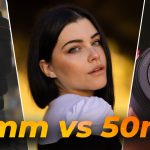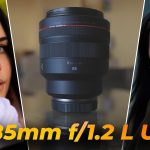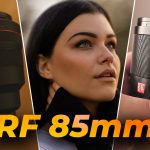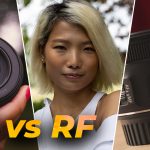Hello there. In this review, we’re going to compare two lenses, the Canon EF 50mm f1.4, and the Canon RF 85mm f1.2 L USM.
If you’re considering investing in either of these, this article will provide insights into their strengths and weaknesses.

Aperture & Focal Length
First off, let’s look at their apertures, and then focal lengths.
So, the Canon RF 85mm lens has a wider aperture compared to the Canon EF 50mm. The 85mm lens opens up to f1.2, while the 50mm lens opens up to f1.4.
The wider aperture of the RF 85mm lens provides an advantage over the 50mm lens. It’s important to note that a lower f-number represents a wider aperture, which leads to better light-gathering ability.
The other numbers in the names of the lenses indicate the focal length, which is a measure of the magnification of the lens. The Canon EF 50mm f/1.4 has a focal range of 50mm, while the Canon RF 85mm f/1.2 L USM has a fixed focal length of 85mm.
The 85mm lens zooms in more than the 50mm lens. Neither lens can zoom in or out; they are fixed. People usually call this type of lens a prime lens.
Why Prime?
So what is the advantage of having a prime lens? Wouldn’t it be better if all lenses were zoom lenses? Wouldn’t that make them more versatile?
In terms of image quality, prime lenses tend to produce sharper images due to their fixed focal length. That’s the advantage of using a prime lens.
Which is Better?
Ok, so which focal length is better? Different focal lengths can produce distinct results as they have different levels of distortion.
The 85mm lens is more zoomed in, so it can fit less in the frame when compared to a photo taken with the 50mm lens from the same spot.
Photographers often favor lenses like the Canon RF 85mm f1.2 L USM for portrait photography because of their sharpness and capability to produce a shallow depth of field.
A shallow depth of field creates a beautiful, soft Bokeh background that makes the subject stand out.
Lens Distortion
Also, it’s important to note that different focal lengths impact the appearance of subjects in the photo, due to their unique distortion characteristics.
For example, a person’s face can look slightly different when captured at 50mm, compared to 85mm, even if the photographer steps back to compensate for the added zoom of the 85mm lens.
Over time, people have come to recognize 85mm as the preferred focal length for portrait photography because they believe it provides the most flattering depiction of a subject’s face.
However, this is not a strict rule, and photographers may choose to experiment with other focal lengths to suit their personal style and preferences.
Bokeh
Now, you might point out the fact that the EF 50mm f1.4 lens can also produce nice Bokeh. Why wouldn’t it be as suitable for portraits?
So, the reason why the 85mm lens would be considered more ideal for portraits, is not only because of its focal length, but also because at f1.2, you get even more Bokeh. Also, because it can open a bit wider, it also allows in more light, so you can do portraits really late into golden hour, without the need to introduce artificial light.
The choice of which lens to use ultimately depends on the intended subject matter. For portraits, the 85mm lens is the clear winner, while for other subjects, it may vary.
Later on in the review, we’ll delve deeper into the specific strengths of each lens, but for now, let’s touch upon portability. How convenient are these lenses to carry around?
Size & Build
The Canon EF 50mm f/1.4 lens measures 73.8 x 50.5mm, or 2.9 x 2″, and weighs 290g (10.23 oz). On the other hand, the RF 85mm lens measures 117.3mm (4.62 inches) in length, 103.2mm (4.06 inches) in diameter, and weighs 1195g (2.63 pounds).
Compared to the EF 50mm lens, the RF 85mm lens is much larger, and heavier. It is important to consider the size and weight of the lens when deciding which one to use, as it affects portability and ease of use.
Both the Canon EF 50mm f1.4 and the RF 85mm lenses are very well-made, with the RF 85mm lens obviously taking the crown on this one. It is among the finest lenses I’ve ever held, and its high price tag is well justified.
Not much of a competition on this one, given how much more expensive the 85mm lens is.
To see the cost of these lenses in your region, check the affiliate links below that I’ve provided for your convenience.

Image Quality
Now, let’s delve deeper into the image capabilities of these lenses. First, we’ll look at the minimum focusing distance, which can be a bit confusing for beginners.
Minimum Focusing Distance
Imagine you want to take a close-up picture of a flower. As you move closer to the flower, the camera will eventually stop focusing, and that is because you are too close to the subject, and the lens can no longer focus on it.
In simple terms, a lens with a shorter minimum focusing distance allows you to get closer to your subject and capture finer details.
Just like the human eye, a lens must maintain a specific distance from the subject in order to focus properly. This is why it’s crucial to consider the minimum focusing distance when choosing a lens.
For instance, the 50mm lens has a minimum focusing distance of 45cm (about 17.72 inches), while the Canon RF 85mm f1.2 lens requires a minimum distance of 85cm (around 2.79 feet).
I realize that newcomers to photography might find the concept of minimum focusing distance tricky, so I want to explain it clearly to avoid any confusion.
Great, now that we’ve cleared that up, let’s discuss sharpness.
Sharpness
Lower-priced lenses often show uneven sharpness, with the centre of the image appearing sharper than the edges. However, most subjects typically sit in the center of the frame, so this isn’t often a major concern.
It’s also worth noting that the difference in sharpness between the centre and edges only becomes apparent when zoomed in significantly.
The good news is that one of the lenses we’re talking about does not have this problem. Obviously, that would be the RF 85mm lens. The EF 50mm lens does have this issue, but again, this is not something that most people will notice.
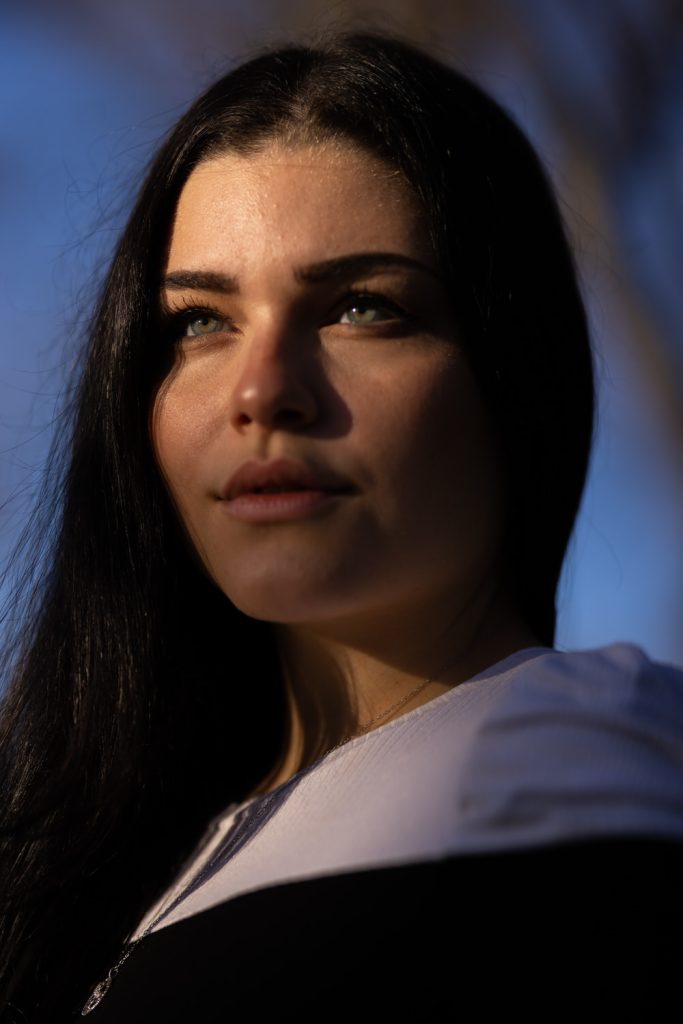
Vignetting
Next, let’s talk about vignetting. This is when the corners of an image appear slightly darker than the centre. While some standards deem it a flaw, many photographers appreciate the vignetting effect in their photos, especially in portraits.
Darkened corners can guide the viewer’s focus to the lighter centre, typically where the subject’s face resides, adding depth and imparting a three-dimensional appearance to the image.
With the RF 85mm lens, vignetting is not an issue, but it can be with the EF 50mm lens. I personally enjoy a touch of vignetting in my portraits, as I think it adds character, so this is something worth thinking about.
Chromatic Aberration
Another aspect to consider is chromatic aberration, which may appear in photos taken under low-light conditions.
It’s an optical imperfection that manifests as blue, green, or magenta fringes along straight lines in low-light photos. While some consider it a lens imperfection, it can lend a distinctive touch to photos, and the general public often overlooks it.
The EF 50mm lens can exhibit chromatic aberration, while the RF 85mm lens does not. The RF 85mm lens actually comes with Blue Spectrum Refractive Optics (BR) that reduce chromatic aberration.
Image Stabilisation
Ok, what about image stabilisation, or IS. Do either of these lenses have it? Nope, which is surprising. You might have expected the 85mm lens to have it, but no.
If you use RF lenses with a camera featuring in-body stabilization, you’ll achieve impressively stable footage, especially in slow motion.
Autofocus
Ok, what about autofocus?
Both are going to do quite well, though obviously, the 85mm lens will do even better. Also, since it can open up to f/1.2, that will allow in more light, which will allow it to focus well in very low light conditions.
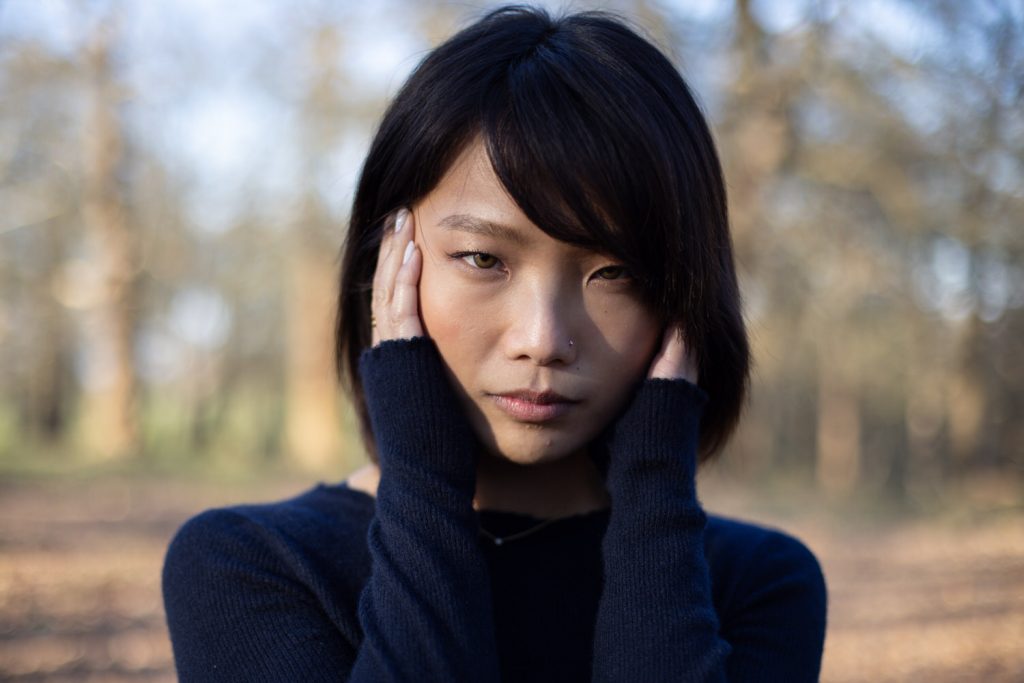
Compatibility
Right, so what cameras can I mount these two lenses on?
The clue lies in the name. So, the Canon RF 85mm lens works with RF cameras, like the Canon R, R5, R6, and so on. On the other hand, the EF 50mm f1.4 lens has a completely different mounting system.
This camera works on EF and EF/EF-S cameras, which make up the majority of Canon’s cameras, especially the more budget ones. Additionally, you can actually mount this lens on an RF body, like the R5. All you need is this adaptor, link down below.
Also, if you want to check out my reviews of the Canon R, or Canon R5, you can watch this playlist on my YouTube channel.
Vlogging
When it comes to vlogging, neither of these lenses is actually ideal. What, you may ask, how can a lens as expensive as the RF 85mm f/1.2 not be suitable for vlogging?
Well, they both have two problems. First off, neither of them has built-in IS, or image stabilisation. This is a problem, as that means that your footage will look shaky.
Now, if you choose to mount either of these on, say a Canon R5, then you would benefit from the IBIS, or in-body image stabilisation that the R5 offers. This will help significantly, but then there’s another problem.
You see, both of these lenses are quite zoomed in. If you’re going to handhold the camera, even with a Gorillapod, at 50mm, you’re probably going to be too zoomed in; not to mention 85mm.
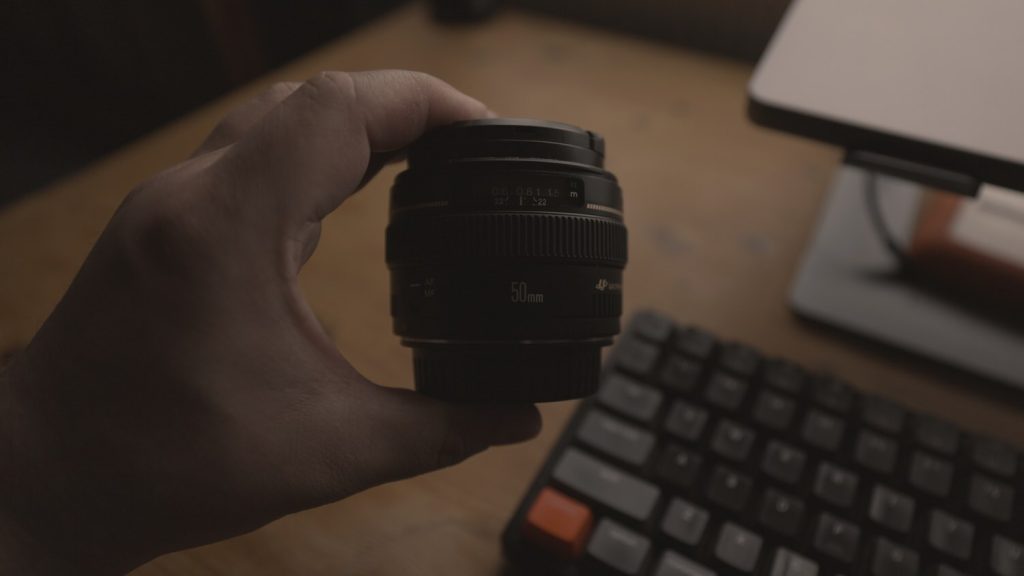
YouTubers
Ok, but what if I don’t need to vlog, but I just want to make content from home, with my camera mounted onto a tripod?
With the camera on a tripod, the lack of IS won’t be a problem for either of the lenses. The RF 85mm will objectively produce a better image, and you’ll also have richer background blur, but the 50mm lens would also work just fine.
The RF 85mm lens is a better option for filming in low light conditions, due to its ability to allow in more light. Both can allow in quite a bit, but there’s a surprisingly large difference between f/1.4 and f/1.2.
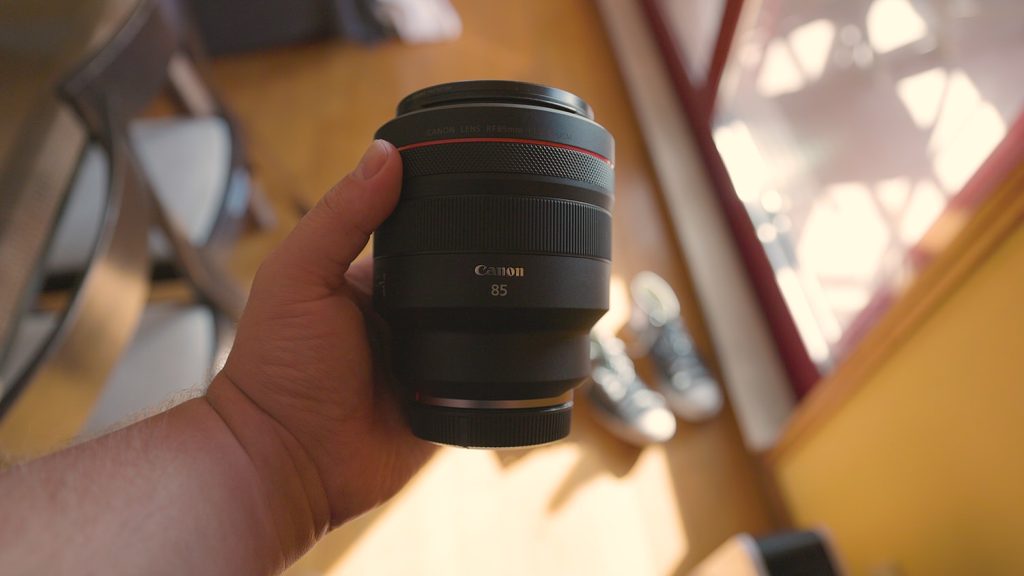
Applications
Ok, so what are these lenses actually designed for?
Portraits
What if you want to do portraits? Both would be suitable, but the RF 85mm f/1.2 lens wins out. 85mm isn’t just seen as the ideal focal length for portraits; f/1.2 also produces a richer background blur, or Bokeh.
Street Photography
What if I want to do street photography? In terms of street photography, either lens would work, though you may get some double-takes, since they both look very professional, particularly when paired with a Canon R5 or a similar camera.
Being aware of your surroundings is important, especially if you’re carrying high-end equipment. The last thing you want is to be caught in a potentially dangerous situation, just because you’re carrying expensive gear.
So, make sure you’re in a safe and secure location, before you start taking photos or filming with these lenses. Because of this, if you’re going out solo, I’d probably just take the 50mm lens. Losing this lens isn’t as significant a setback as losing the RF 85mm lens.
Alternatively, only go out to take photos in groups, if you’ll be showing off expensive gear.
This obviously depends on where you live, but I personally wouldn’t be walking around London with my R5 and RF 85mm lens.
Product Photography
Ok, what if I want to do product photography?
In terms of product photography, both lenses would actually work rather well.
Landscape Photography
Right, what about landscape photos?
If you want to capture more of the landscape, then the 50mm lens would be the better option, but if you want to focus more on a specific object or subject within the landscape, then the 85mm lens would be a better choice. Both would work, and to be honest, the magnification difference between 50mm and 85mm isn’t that noticeable.
Fashion Photography
How about fashion photography? Overall, it ultimately depends on what type of photography or videography you want to do. If you want to do portraits, the 85mm lens is a clear winner.
In the case of the Canon R5, the in-body image stabilisation would help a lot with the video. If you’re also going to slow the footage down, the 85mm would still work well.
Documentary
What about documentary-style shooting? For a documentary-style shoot, both would work well, but the RF 85mm has more weather sealing, which would make it more versatile when shooting in various locations and types of weather.
Sports or Wildlife Photography
What if I want to capture sports, or wildlife? Neither lens is really designed for this use. The 85mm lens reaches further, so technically it is more suitable, but realistically, neither of these lenses can get you close enough to what you’d like to capture.
Wedding Photography
For event or wedding photography, either lens can be utilized, depending on the desired shot. The EF 50mm f/1.4 lens is ideal for capturing larger groups, as it has a wider field of view. However, for close-up, detail shots, the RF 85mm lens is preferable as it offers a more zoomed-in perspective without having to get too close to the subject.
Either would work, and if I only had to pick one, I’d probably just go with the 85mm lens.
General Photography
Ok, what if I need a more general lens, that can do more of everything? In that case, I’d probably have to say the EF 50mm lens. It’s a bit less zoomed in, whilst still being good for portraits. The fact that it allows in quite a bit of light at f/1.4 also helps a lot.
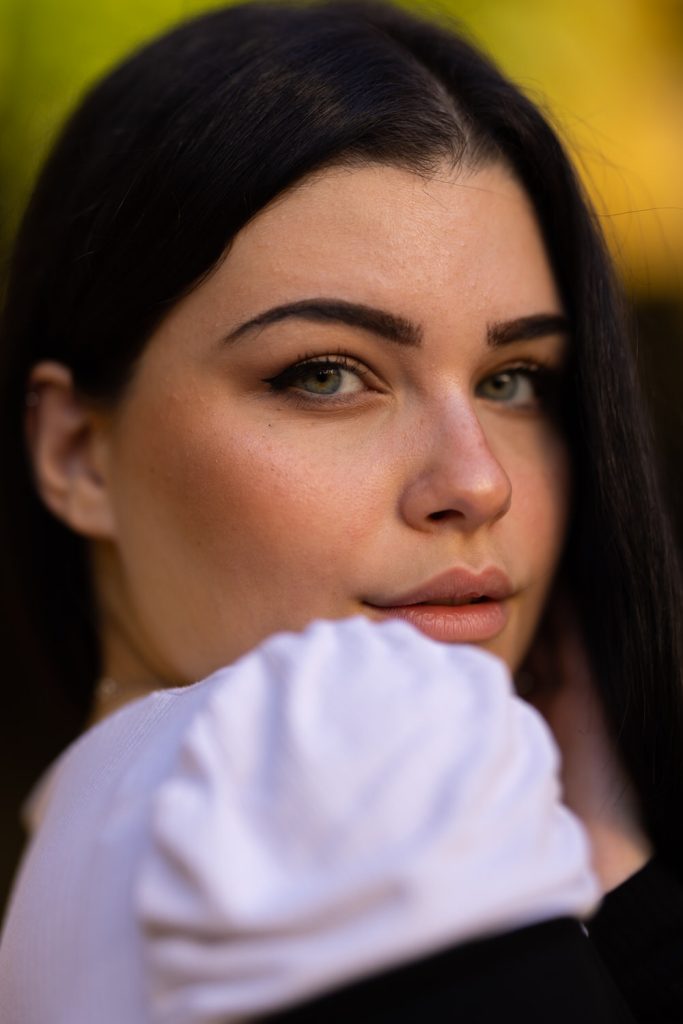
Control
How easy are they to use?
Both lenses are of premium quality and provide a pleasant shooting experience. They both have smooth manual focus rings, which allow you to precisely adjust focus.
Additionally, the RF 85mm lens has a programmable ring that can be set to control functions such as changing ISO, thus providing added flexibility.
However, some photographers may prefer not to use this feature as there is a risk of accidentally altering settings during a shoot. Nevertheless, it is a valuable option to have.
Longevity
Right, so how long can I expect them to last? Both lenses have metal mounts, which bodes well for their longevity, but only the RF 85mm lens has some weather sealing, which makes it resistant to dust and splashes.
Adding a UV filter as an extra layer of protection for the lens element is a common practice for many photographers, including myself.
My lenses are equipped with Sigma ceramic UV filters that remain on at all times, having been attached immediately after purchase.
The Sigma ceramic UV filters can be quite expensive, but it’s worth it when protecting even more expensive lenses.
Having a filter attached also eliminates the need for lens caps, although they can still be used if desired. When purchasing filters for these lenses, it’s important to keep in mind their filter size, which is separate from their focal lengths.
The EF 50mm lens has a filter size of 58mm, while the RF 85mm lens filter size is 82mm.
It’s important to know this, as most people initially get confused, and believe that focal lengths and filter sizes are the same thing.
Conclusion
In conclusion, which one should you buy?
Ok, so this is a bit of a tough decision. Let’s make it a bit easier by figuring out which camera you have, or which you intend on buying.
Will it be something like the R5, which has built-in image stabilisation? If so, the lack of IS on the RF 85mm lens doesn’t matter quite as much, as the camera stabilisation will somewhat compensate for the lens’s lack.
What Are Your Needs?
Next up, what do you want to use it for? Is it mainly portraits? If so, the RF 85mm lens is your best bet. It’s practically designed for that purpose.
On the other hand, do you want something that can do a lot of the things that the 85mm lens can do, but for a lot less money? If so, the EF 50mm f/1.4 lens is your choice.
Just bear in mind that if you’re going to use it on an RF camera, you’re going to need to purchase an adaptor, in order for it to work.
I hope this has been helpful. If you’re curious as to how much these lenses cost where you are, I have affiliate links down below, which you are free to check out.
Now, if you’re looking to upgrade your photography and videography skills, you might want to check out some of my other reviews on my YouTube channel.
If you’d like to purchase any of the items I’ve mentioned in this article, or see how much they cost in your country, I have a link down below where you can view them.
Thank you for reading my comparison review of the Canon EF 50mm f1.4 vs Canon RF 85mm f1.2 L USM.
Recommendations
I hope this has been helpful. I invite you to have a look at some of my other articles. We have something for everyone, whether you’re interested in audio, or cameras and lenses. Alternatively, if you prefer video reviews, feel free to have a look at my YouTube channel.
Finally, down below you will find all of the items I talked about in this article.
